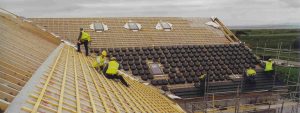2-3 WORKING DAY DELIVERY

Which Is The Best Breathable Roofing felt?
To ensure that you buy the best breathable roofing felt for your project, you should first consider what particular stresses and strain your felt will be exposed too. The best membrane for one project, may in different circumstances, perform poorly on another. Let me try to explain.
Breather Membrane Benefits
Breathable roofing felt, or breather membrane is considered a vital component of all new builds, extensions and re-roofing projects. It offers significant advantages over traditional 1F slater’s felts:
-
- Allows water vapour to exit your roof space, preventing condensation from dripping back in.
- Stops wind-driven rain and snow from being blown into your roof through gaps between tiles and slates.
- Enables air to circulate, discouraging the formation of mould and rot.
- Reduces or removes the need for expensive/ugly air vents.
- Lowers heat loss, saving you money and lower carbon emissions.
- Provides a temporary roof, during the building’s construction.
- Minimises the likelihood of slates and tiles being blown off your roof (by reducing the impact of wind lift).
- Acts as a barrier to insects, dust and airborne particles.
In essence, we are asking these fabrics to do many things at once:
- Breath (which require more numerous, or larger holes for air to pass through).
- Waterproof (which require fewer or smaller holes to stop water from leaking through).
- Strong (which requires more fabric).
- Flexible (which requires less fabric).
Of course, no single fabric can do each of these things, all at once. This is why manufacturers are forced to target their products to particular strengths. Some choose to target the most breathable, others the strongest or most water-proof.
Thankfully we don’t have to rely on the manufactures telling us which product is best. Most breather membranes on the UK market are tested by the British Board Agreement (BBA). By studying the results of the BBA certificate, you will be able to work out which is the best breathable roofing felt.
Before wading in at the results, it’s worth looking at the BBA test in detail. This will really help you understand how well the material will function in the different areas it will be exposed to. And therefore to be able to pick the one that is best for your roof.
Breathability and Water Tightness

Breathable roofing felt allows your roof to breath whilst preventing water penetration. It works in a similar way as to how a Gortex jacket protects an athlete from getting too hot and sweaty, whilst protecting them from wind, rain or snow.
Three parts of the BBA approval process test this functionality. Good breathable roofing felt will perform well across all three sections of the test.
Resistance to Water Vapour:
This section of the test checks how quickly a breathable membrane allows moisture-laden air to escape your roof. To qualify as a low resistance (LR) membrane, it must have a vapour resistance of less than 0.25MNs/g. The lower the figure the better (they will allow more water vapour to disperse more quickly).
Moisture (water) Vapour Permeability:
The measure of how much moisture passes outwards through the breathable membrane in 24 hours. A higher value is preferable.
Water tightness:
The breathable felt must be able to channel water into your gutters. To achieve this, the top layer of the fabric must be watertight. The BBA certificate tests for water tightness by measuring how high ahead of water can be contained, (the higher the result, the less likely the fabric is to allow water through). To ensure ‘real-life’ results, both aged and un-aged samples are tested. A W1 pass is a requirement for BBA certification.
Tensile Strength / Nail Tear Strength

In addition to lasting the lifetime of the roof, a breather membrane has to be tough. This is so that it can withstand the installation and build process. It also has to last through repeated winter gales and hot summers.
During installation, the material must withstand accidental puncture and snagging against wood splinters, rough edges or nail heads. Where the felt has been punctured, it must be tear-resistant (to stop the puncture hole from growing in size).
Until slates or tiles have been installed, it is likely that there will be a period of time (from several days to several weeks) when the breathable roof membrane is the only weather protection on your building. During this time, it has to be strong enough to withstand the full force of the British climate.
BBA certification tests the normal tear strength of the fabric.
A second test is performed to review how strong the fabric is after it has been punctured by a nail or a sharp point. The better it performs in these tests, the more likely it is to last longer. Both as a temporary roof covering during installation and as a protective ‘second skin’ in the roof.
Tear strength is particularly important to professional roofers who need to lay large volumes of breathable roofing membranes quickly and without fuss. This is also of interest to the beginner roofer, who may find the fitting process very awkward the first time around.
To strengthen their products, some manufacturers even add a fourth layer grid system which acts both to strengthen the fabric and prevent nail holes and snags from spreading.
UV / Temperature Stability:
A breathable roof membrane/vapour permeable underlay is designed to be installed on your roof many days or even weeks before the final covering of slates or tiles. However, a vapour-permeable underlay will deteriorate with sustained exposure to the effects of UV light and temperature.

Wind Loading:
Wind blowing over and through your roof-space creates areas of high and low pressure. With an unprotected roof, slates and tiles are at risk from blowing out from the roof at the point where these low and high-pressure differences are greatest.
You can reduce the likelihood of your slates or tiles blowing out of your roof by minimising the strength and speed of the wind passing through your roof. A heavier or stronger breather membrane is more likely to restrict wind better and is less likely to split. You do not want to reduce airflow completely (it will stop the roof from breathing).
Conclusion: What is the best breathable roofing felt?
There is no single breather membrane that is the best in every situation. This is because it is simply impossible to design and manufacture a membrane that is the best at everything (breathability, water-tightness & strength). Instead, manufacturers will optimise their products towards either strength/durability, vapour control or water-tightness.
Consider what specific pressure your breather membrane will be exposed too. Some properties will be more vulnerable to wind uplift (where a stronger membrane would be better). Other roofs may be exposed to a higher degree of water condensation (where a more breathable membrane would be suitable). Once you know this, your choice will become more obvious.
Our own list of favourites:
For New Builds / Breathability: Proctor Roofshield
For Strength: Klober Permo Forte
For All Round Performance: Tyvek Supro
Has this article helped you choose? Do you have any experience you would like to share on what are the top breather membranes for roofs. Please share with us your views on what is the best breathable roofing felt!






Stay Connected With US
Address
Harrison Way, Matlock, Derbyshire, DE4 2LF
Email
sales@ashbrookroofing.co.uk
Phone
01629 732988
Order Online
24/7 hours a day
